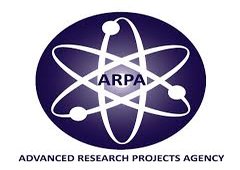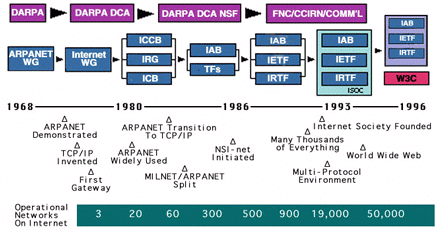Early Years: 1960's-1994
The Internet that many of us take for granted today arose from a series of government-funded computer networking efforts. In 1969, the precursor to the Internet began with the U.S. Defense Department's ARPAnet. ARPA-funded researchers developed many of the protocols still used for most Internet communication. Several other agencies also developed networks so their researchers could communicate and share data. In 1981, for example, the National Science Foundation (NSF) provided a grant to establish the Computer Science Network (CSNET) to provide networking services to all university computer scientists.

In 1985, NSF considered how it could provide greater access to the high-end computing resources at its recently established supercomputer centers. Because NSF intended the supercomputers to be shared by scientists and engineers around the country, any viable solution had to link many research universities to the centers.
NSFNET went online in 1986 and connected the supercomputer centers at 56,000 bits per second—the speed of a typical computer modem today. In a short time, the network became congested and, by 1988, its links were upgraded to 1.5 megabits per second. A variety of regional research and education networks, supported in part by NSF, were connected to the NSFNET backbone, thus extending the Internet’s reach throughout the United States..
Creation of NSFNET was an intellectual leap. It was the first large-scale implementation of Internet technologies in a complex environment of many independently operated networks. NSFNET forced the Internet community to iron out technical issues arising from the rapidly increasing number of computers and address many practical details of operations, management and conformance.
Throughout its existence, NSFNET carried, at no cost to institutions, any U.S. research and education traffic that could reach it. At the same time, the number of Internet-connected computers grew from 2,000 in 1985 to more than 2 million in 1993. To handle the increasing data traffic, the NSFNET backbone became the first national 45-megabits-per-second Internet network in 1991.

The history of NSFNET and NSF's supercomputing centers also overlapped with the rise of personal computers and the launch of the World Wide Web in 1991 by Tim Berners-Lee and colleagues at CERN, the European Organisation for Nuclear Research, in Geneva, Switzerland. The NSF centers developed many tools for organizing, locating and navigating through information, including one of the first widely used Web server applications. But perhaps the most spectacular success was Mosaic, the first freely available Web browser to allow Web pages to include both graphics and text, which was developed in 1993 by students and staff working at the NSF-supported National Center for Supercomputing Applications (NCSA) at the University of Illinois, Urbana-Champaign. In less than 18 months, NCSA Mosaic became the Web "browser of choice" for more than a million users and set off an exponential growth in the number of Web servers as well as Web surfers. Mosaic was the progenitor of modern browsers such as Microsoft Internet Explorer and Netscape Navigator.
Brief History of NSF and the Internet https://www.nsf.gov/od/lpa/news/03/fsnsf_internet.htm